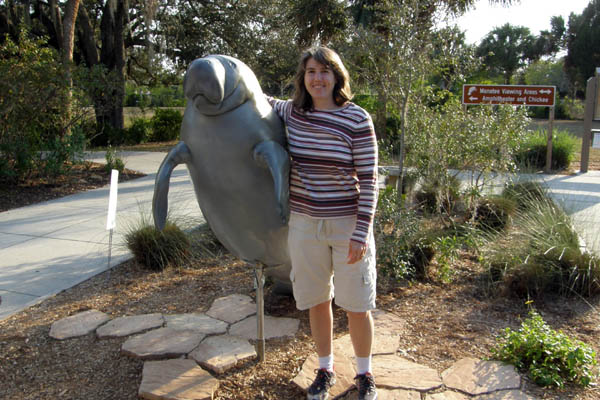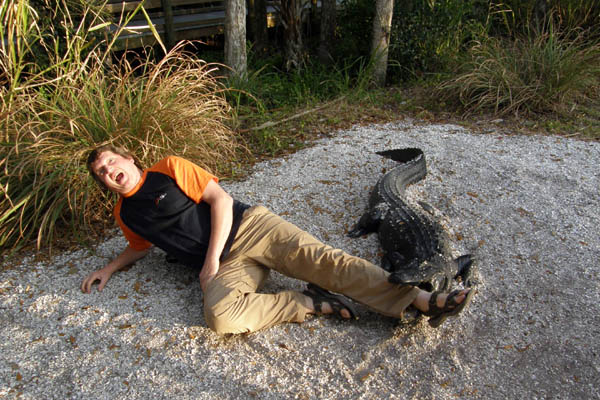There was an altercation in the parking lot outside our room last night, yelling only, I think, but we didn't get up to check. No police came, though someone was threatening to call them. I assume it would take a lot for the hotel staff to call the police out to this place.
We'd come to the Miami area to visit Key Biscayne, where Tom lived and worked once upon a time when he was 18. Alas, Sundays on the Bay, the marina-side restaurant with the colorful crowd where Tom once bused tables, is long gone, replaced by so-many boat slips. I'd heard a lot of stories about this place over the years and was sorry I didn't get to meet any Miami mobsters.

An iguana of Key Biscayne
The town of Key Biscayne Tom was happy to find little changed from the '80s, though it was a lot harder to navigate the narrow, crowded streets in our car than it was the bicycle he used in 1983, and parking is a problem.

Downtown Miami
Leaving Key Biscayne, we got on I-95 north and then I-595 west to leave Miami behind us as quickly as possible - no reason to visit the beach on a cold, gloomy day like today. At Highway 27 we turned north toward Lake Okeechobee, crossing the 20,000-acre Florida King Ranch along the way, a much smaller division of the original King Ranch in Texas. The Florida "ranch" is actually a 100-percent farming operation, with no ranching at all. This is sugarcane country, and we saw fields burning along the way. Sugarcane is burned before harvest to remove the extraneous leafy material and leave only the stalks, from which sugar is extracted.

South Bay, Florida
Lake Okeechobee, a/k/a The Big O, has a surface area of approximately 730 square miles and is the second largest freshwater lake wholly within the United States, second only to Lake Michigan. Its maximum depth is 14 feet, with an average depth of only 9 feet. The lake is enclosed by a 20-foot dike, blocking the view of the lake from the road, but saving countless lives. The dike was increased to this height after storm surge from two hurricanes in the 1920s killed over 2,500 people. In South Bay we drove to the top of the dike for a look at the lake.

Lake Okeechobee
We had a very late lunch at Subway in Clewiston and pushed on west. In North Fort Myers we stopped at a boat ramp in a neighborhood along the Caloosahatchee River and admired the view. The weather was warmer this afternoon, and it was nice just to wander around outside.

Caloosahatchee River
Just before we reached Fort Myers, we visited the Lee County Manatee Park. Manatees, also known as sea cows, are large, gray, aquatic mammals with two flippers and a paddle-shaped tail. They average 10 feet in length and weigh up to 2,000 pounds. Tradition has it that manatees were the inspiration for the mythical mermaids. That's some unattractive mermaids!

Jana stands by her manatee
The Manatee Park is a non-captive refuge for manatees, meaning they're not confined and can come and go as they please. Optimum viewing times are November through March due to the cool gulf temperatures. Manatees congregate here because of the warm water discharged from the adjacent power plant.

Lee County Manatee Park

Curious manatee

Sleeping manatee

Alligator attack!
In Fort Myers we secured a hotel room with little trouble at a Super 8, a very good value, but far less interesting than last night's accommodations!